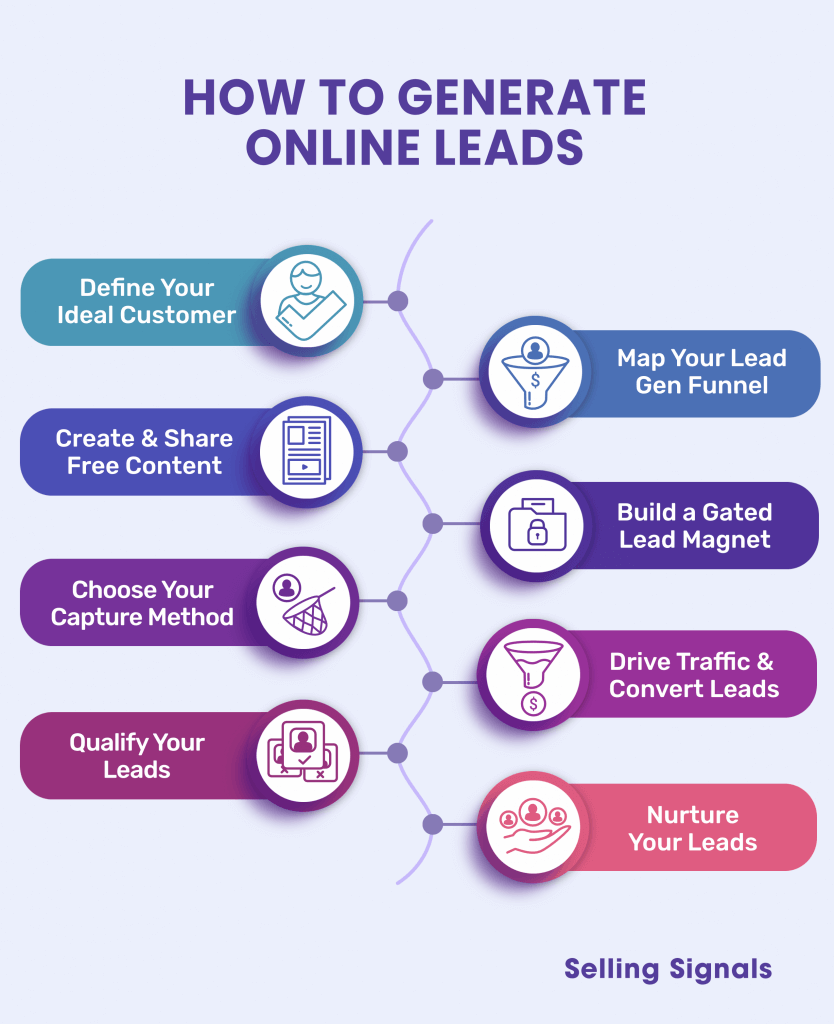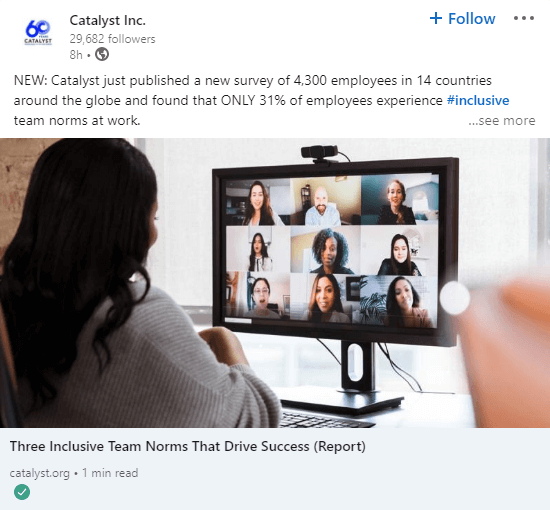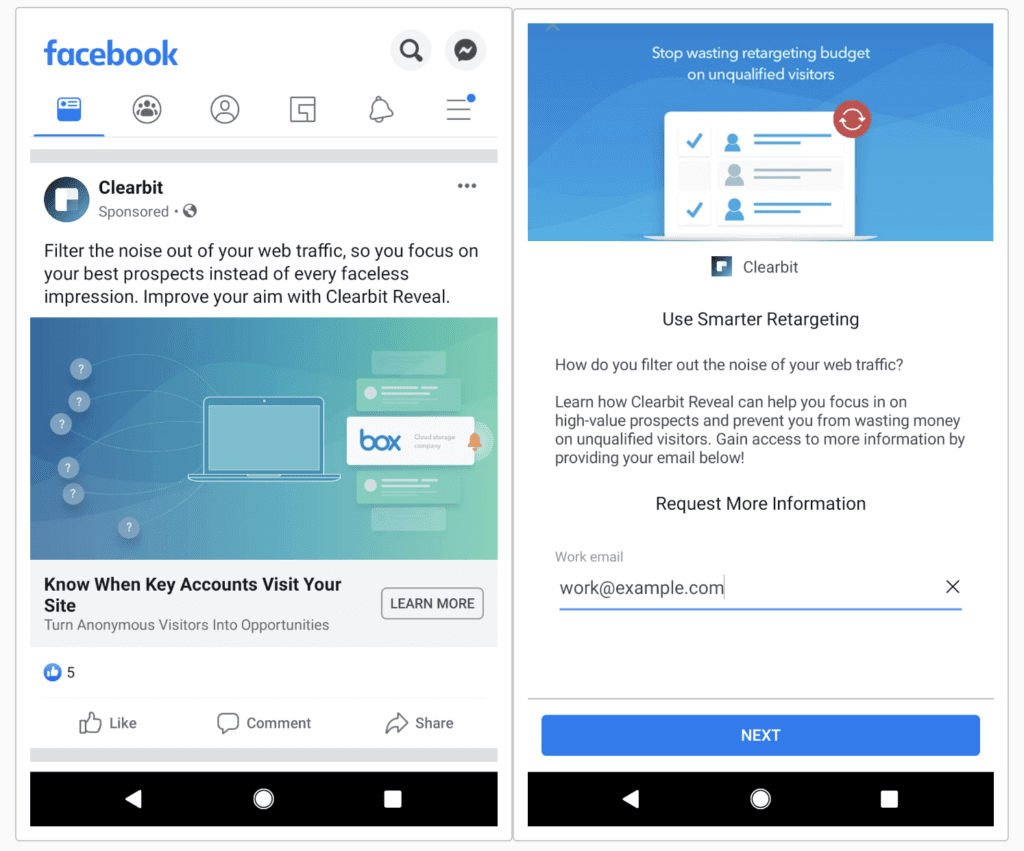-
News & Trends -
Sales -
Marketing Related Topics -
B2B Software Guides Related Topics -
Free Tools & Resources -
- About Us About Us


Online lead generation is the inbound processes businesses use to attract and convert strangers into curious leads via online methods. It usually involves driving people who fit your ideal customer profile to a lead magnet that offers them something valuable in return for their contact information. The visitor becomes a lead when they take an action that signals their interest in your business, and then the marketing and sales teams qualify and start pitching them.
Businesses generate online leads using various strategies, all of which fall into the same general seven- or eight-step process. The marketing team typically defines their ideal customer, maps their lead generation funnel, creates free content for their audience, and then designs a lead magnet to attract that audience. Once they have a relevant, valuable magnet, they plan their lead capture method and drive online traffic so good-fit leads can find and trade their contact info for it.
What happens next depends on your business type and the information you collect from your leads. For instance, a small B2C business collecting email addresses in return for an ultimate guide might send leads emails until they're ready to purchase. A B2B brand sourcing phone numbers might score the leads and have their sales reps call and qualify each lead that reaches a certain scoring threshold, at which point they'll further qualify and nurture them into a customer.
Outbound lead generation, on the other hand, consists of prospecting activities like cold calling, cold emailing, and LinkedIn social selling. Some businesses choose to generate leads using a hybrid approach, attracting some leads through online lead generation while also reaching out directly to others. To learn more about the differences between the types of lead generation methods and decide which to do, check out our article on inbound vs outbound lead generation.
While there are offline ways to generate inbound leads, we won't cover them in this article. However, you can read this post on offline inbound lead generation to learn more about those efforts, such as fliers, direct mail, brochures, or billboards. Online lead generation is a form of inbound lead generation, so below, we’ll address all online ways to generate inbound leads.
Broadly speaking, there are seven main strategies that you can use to generate leads online. These strategies include using a lead generation website, an SEO-optimized blog, organic and paid social media, paid Google ads, and affiliate marketing, and most also involve the strategy of creating and sharing a lead magnet relevant to your audience. We explain each in more detail below:
In the lead generation website strategy, you drive visitors to a landing page on your website, where they fill out a form to receive your lead magnet. People fill out the form with the information you request (e.g. name, email, company).
Regardless of the strategies you choose, the overall process for lead generation is the same — you’ll drive traffic to a certain location where you can capture leads' contact information. Let's now take a look at the eight concrete steps you can take for online lead generation.
Online lead generation is all about creating an effective lead magnet and driving quality traffic to it. If the people who see your magnet like what you’re offering, they’ll click on it and begin their buyer journey with your company. To make this happen, you'll decide who you're targeting and how, and then you'll plan to collect their information and qualify them.
More specifically, the eight steps to do this are:

Let’s now take a look at the entire process in more detail. By the end, you’ll understand how to create your own online lead generation process by leveraging your website, social media, and more.
The first step is to define the specific lead you’re targeting, which will dictate the type of lead magnet and the traffic sources you’ll use. You need to push your lead magnet to the people who are good fits for your business; otherwise, you'll attract leads into your funnel who will eat up marketing resources and never buy. To identify your ideal customer, create a customer profile and buyer persona — descriptions of the person or business that’s a perfect match for your product or services.
First start with a customer profile template and use your existing customer data to fill it out. Consider details such as demographics, firmographics if you're a B2B business, and geographic information. Once you have this high-level view of your ideal customer, futher break that down into a buyer persona. Fill out a quality buyer persona template to create an example of the specific person you're targeting, including information like their motivations, goals, and pain points.

To learn more about building these information tools for your business, read our articles on how to create a customer profile and a buyer persona. Once you have a solid picture of your ideal lead, you'll map out the funnel through which you'll take them.
A lead generation funnel maps the journey of a lead from their awareness of your brand to the action they take that signals that it's time to qualify and nurture them. Typically, that action is to sign up for a newsletter, download a piece of content, or exhibit another behavior matching your call-to-action.
Creating a lead gen funnel involves identifying the stages needed to move a lead from top of funnel (awareness or discovery) to middle of funnel (interest and desire) to bottom of funnel (action and qualification). You'll then decide on the actions each lead takes before you consider them to be in the next stage of the funnel, as well as your own touchpoints that you'll follow to inspire them to take those actions.
Here are the steps to draw up your lead generation funnel:
After creating your funnel, you can optimize it through strategies such as testing the buyer journey yourself, ensuring that your free content is SEO-optimized, implementing lead funnel software, and tracking how many leads make it through your entire funnel. Let's dive deeper into creating your free content next.
For more detail on how to craft a lead generation funnel that helps you convert online leads, check out our article on mapping your lead generation funnel, including instructions for creating and continually optimizing it.
The best way to familiarize people with your brand and increase the conversion rate of your future lead magnet is by creating and sharing free content. It’s difficult to get someone unfamiliar with your brand to give you their contact info. People who know and trust your brand, on the other hand, will feel at ease giving you their information in return for a lead magnet offering.
Free content consists of blog posts, articles, and videos that are all relevant to your industry and promoted organically via social media or Google search. For example, Catalyst published a survey report their audience will find useful and shared it organically on their LinkedIn page:

80% of the free content you create and share should be educational and informative, asking for nothing in return. The other 20% should have a clear call-to-action with the main purpose of collecting their info in return for the magnet you'll create next.
A lead magnet is a free and valuable resource that you offer to your audience in exchange for their contact info. Examples include a free demo, a helpful ebook, and a seat at a webinar. These magnets usually represent premium content residing behind a “gate” that can be opened only with the submission of contact information (name, email, number, etc.).

Lead magnets can take many forms. What matters most is that it is something your audience wants. For instance, if you are selling cookbooks to college kids, you might give them free recipes in exchange for their emails.
To create a lead magnet, take the following steps:
After you create the lead magnet, you'll add it to your website, plan how you'll deliver it, and promote it everywhere that makes sense. Besides winning your leads' contact info, when you give them something valuable, they will start to trust your brand and your expertise. Therefore, they'll be more likely to become a paying customer down the line.
For a detailed article on the best types of lead magnets, along with key templates to use, check out our ultimate guide on creating high-value lead magnets, including who each option is right for.
Now that you have your lead magnet, decide where you want it to live and capture lead information. You can offer it on your website via a landing page or via lead capture software like embedded forms or popups. Alternatively, there are social media ads that let you offer your magnet and collect lead information directly on their platform. Let's look at both options.
Turn your website into a lead capture tool by creating a landing page and using lead capture software on that page and/or your home page. Your landing page acts as a sales page that visitors land on after clicking on one of your traffic drivers (e.g., a social ad). It’s crafted with one goal in mind: getting the visitor interested enough in your lead magnet to trade their information for it.
The process to create a lead gen website is below:
Plan out your lead gen funnel, optimizing the buyer journey from awareness to action.
Figure out where your traffic currently comes from or where you'd like it to come from.
Ask for visitors' email addresses in exchange for your lead magnet or to speak with your team.
In addition to your home page, choose popular blog posts or other webpages and add lead magnets that directly relate to the post or page.
Using lead capture software, embed forms or popups directly onto the post or page to trade it for the lead's information.
Build the page where you'll direct leads that find your lead magnet on social media or other platforms.
Use action words to encourage potential customers to exchange their information for the lead magnet.
Use live chat software to quickly answer visitors' questions and start to qualify and nurture them.
Add a subscribe page to your site so leads can opt in to future communications.
Use popups, blog content, backlinks, and local SEO to ensure that potential customers can find you when they type a relevant query into Google.
Check and improve your website's speed, stability, and structure, and make sure it works well on mobile.
Test details such as the number of fields in forms, your page's language, the layout of a landing page, and offline traffic sources to improve your visitors' experience.
When building your lead gen website, also make sure you can actually deliver the lead magnet. Some lead capture software allows you to do this automatically via an email or download link. Other times, you’ll have to use an email marketing tool to deliver the lead magnet. Look into the software you're using and plan this out prior to collecting any leads.
For a full guide on how to capture online leads using your website, check out our in-depth article on creating and optimizing a lead generation website, including steps and best practices.
The other method for capturing online leads is to do so directly on a social media platform via paid lead ads. This is good for businesses that don’t want to optimize their website for lead generation or that want to shorten the number of steps it takes to capture lead contact information. Currently, Facebook and LinkedIn offer ads that capture lead contact details directly on their platforms.
The way this direct social media lead capture works is simple. You run an ad offering your lead magnet on LinkedIn or Facebook. Within the ad is an embedded form that users must fill out to receive the magnet. When they click it, instead of being transported to your site, they remain on the platform and fill out the form that appears, which includes fields for their contact details.
This strategy is effective because it reduces friction for the user. On both platforms, the embedded form will auto-populate with the user’s information, all without sending them off-platform to an unfamiliar website. To learn more about each, check out our articles on LinkedIn lead gen forms and Facebook lead ads.

If you’ve decided to turn your website into a lead generation tool, you’ll need to drive traffic to the lead magnet on your site. There are multiple ways to do this, including free and paid Google and social media strategies, plus affiliate marketing. Let’s go over the five best strategies to drive online traffic to your magnet.
You can generate traffic organically through SEO lead generation, which involves creating articles that are relevant to your ideal customer, posting them on your website, getting them to show up organically when your audience searches for the topic, and then trading your lead magnet for their contact information.
To use organic SEO traffic to your advantage, first optimize your site for the leads that come in through SEO, then create your content strategy and write the relevant articles. Next, generate backlinks to help push your articles higher on the Google results page. Finally, capture your leads' contact information and qualify and nurture those leads.
For more information on how to generate organic SEO traffic and capture lead contact information, check out our ultimate guide on SEO lead generation, which includes a breakdown of SEO and the process for generating leads.
PPC stands for pay-per-click, an online advertising model where you pay a fee each time a digital ad is clicked and traffic is sent to a specific destination. One of the most popular forms of PPC is text-based search advertisements via Google Ads. Advertisers bid for top ad placement on the Google results page for relevant keywords.
The steps to generate leads through PPC ads involve defining your ideal customer, mapping your lead funnel, identifying the most relevant keywords to your audience, setting up your ad campaign and the text in your ad, and capturing the information of leads that click the ad.
If you're interested in launching a PPC Google Search campaign, read our ultimate guide on PPC lead generation for web leads, including a breakdown of the steps.
You can drive traffic to your lead magnet for free by generating social traffic on platforms like Instagram, Facebook, LinkedIn, Pinterest, or Twitter. Essentially, your goal is to build a following to which you can market your lead magnet. You build this following by consistently posting valuable, entertaining, or educational content specifically created for your target audience.
To choose the right platform, determine which one(s) your ideal customer uses, then research which currently bring your competitors success. Ask yourself whether each platform allows you to generate leads how you want (for example, Instagram is a good option if you want to attract leads using photos), and decide whether you want to put in the type of effort that each platform requires (for example, don't use Instagram if you don't have the bandwidth to upload photos).
For a breakdown of all the major social media platforms, check out our ultimate guide on social media lead generation, which includes strategies for organic and paid methods to attract leads.
Similar to organic search engine traffic and paid Google ads, you can pay for traffic with social ads. These are ads that you run across social media platforms so they show up on users' news feeds and offer them your lead magnet. The platform you choose depends primarily on where your customers hang out on the web (for example, Facebook is a good tool for B2C sellers, while LinkedIn is more appropriate for B2B ads).
For more information on paid social media ads, check out our articles on Facebook lead generation and LinkedIn lead generation, where you’ll find the top strategies for both platforms. You can also learn more about how to choose between leading users that click your ad to a landing page to claim their lead magnet or keeping them directly on the platform by using Facebook lead ads or LinkedIn lead gen forms.
As you use Google and social media to direct traffic to your website and magnet, you can also use affiliate marketing to incentivize influencers outside of your company to promote your brand or offering to their own networks. Benefits of affiliate marketing don't just include expanded reach to a new audience. Because the marketer you hire is not an employee at your company and has already built rapport with their followers, those leads will be more likely to trust them.
The basic steps to set up an affiliate marketing program include defining how you'll pay your marketers — for example, per click or conversion — joining CJ or a similar network to help you manage your program and payments, and finding and giving marketers their own tracked link. If you pay per click, qualify your leads in the next step to confirm that they could actually convert. For more on how to set up your own program, check out this article on affiliate marketing.
When a marketing team captures inbound leads online, they qualify them before passing them along to sales. Typically, this is done using a lead scoring model that accounts for each lead's demographics and the behaviors they take with your brand. Next, a salesperson can qualify them further as a sales accepted lead via a needs assessment and then as a sales qualified lead through a discovery call.
Below are the complete steps to create your lead qualification process:
If you find that you're disqualifying too many leads, this could indicate that you need to modify part of your online lead generation strategy. Continue tweaking it until you're comfortable with the ratio of qualified to disqualified leads.
To learn more about qualifying the leads you attract through online lead generation, read our article on lead qualification. There, you'll find detailed information on the three stages a lead can progress through and the steps to create your own lead qualification process, including lead scoring and a discovery call.
With your leads now qualified, continue to nurture them so you can generate sales. Often times for companies like online SaaS companies, marketers will nurture leads through email nurturing campaigns that drive traffic to sales pages for conversion. For companies with longer sales cycles that require sales support, marketers will typically hand off qualified leads to a salesperson or team for further qualification and nurturing. For some companies, a hybrid approach is best.
For more information on how to nurture online leads, check out our article on email nurturing. There, you'll learn the strategies and steps to both set up an email nurture campaign as well as craft engaging nurturing emails.
If you're interested in trying online lead generation but you don't have the time or staff to do it well, there are several types of companies that can help you depending on where you want to find your leads. These include lead generation companies, general social media ad agencies, and social media ad agencies that focus on a specific platform, such as Facebook. Take a look at each type below, along with what they typically help with.
Lead gen companies are businesses that learn about your ideal audience and then use inbound or outbound lead generation to find and capture appropriate leads for you. These companies tend to focus on B2B businesses, and most work with you to create a custom strategy involving attracting leads on social media or through other methods and qualifying the leads before passing them to you. Some lead gen companies even help you nurture and convert the leads.
To learn more about the top agencies that can help you generate online leads, check out our article on the best lead generation companies and compare their offerings and prices.
There are many companies that can help with various aspects of your online lead gen strategy, so first consider what you actually need, and then dive into those options. If your goal is to generate leads from multiple sources, a lead gen company might be the best option. If you'd like to focus on a few social platforms, a social media ad agency can increase your reach. If your leads are mainly on a specific platform, an ad agency focused on the platform of your choice would be best to start with.
Online lead generation has many benefits for salespeople, marketers, and business owners. Below, we've listed a few of online lead generation's pros, most of which you likely won't experience with sales prospecting or other types of inbound lead generation:
If you set up your online lead generation strategy correctly, the majority of people viewing your offer and giving you their information will be qualified. This leads to shorter sales cycles and saved resources such as ad spend.
With inbound leads, salespeople can focus on calling those who have already expressed interest in the company. This saves them time.
Many of these strategies require you to market to your target audience. Whether it’s through social media or content marketing, you are building a brand and awareness around it.
When you offer your buyers something like a lead magnet, and they find it valuable, you have earned some trust points with them.
When you collect email addresses, you can email market to them. Then, according to how they interact with your emails and any new information you learn about them, you can personalize your phone call.
There is a hefty amount of available data in online marketing that you can use to guide your strategy. Metrics can show you what’s working and what’s not. You can tweak your ads, content strategy, or landing page and see real-time effects.
If you have the resources to try online lead generation, you'll likely find it to be worth the effort you put into it, especially if you learn how to do it well.
No matter which of the online lead generation strategies you choose, there are some best practices to guide you along the way. Take a look at these top four tips to keep in mind:
It’s critical that you maintain knowledge about who your typical customer is and what they need. If you are going to market to them properly, you should know their demographics, attributes, and pain points, as well as what content they love to see and what they respond to. Therefore, revisit your buyer persona every quarter at a minimum. This will ensure your messaging stays relevant to your audience.
Not all of your potential buyers find their information through the same means. Some will be on Facebook. Some will Google every industry-related question that pops into their head. To ensure you are reaching as many of them as possible, use a variety of marketing channels. Try content marketing in tandem with social media marketing. In general, a diversified method is best.
If you are using social media to drive traffic to your landing page, you should be spending time making posts that don’t relate to your offer. Instead, they should be engaging posts like questions or funny pictures that relate to your audience. If done right, people will comment on the posts. Instead of neglecting them, comment back. When they receive a reply from you, they will feel more connected to your brand.
Whether it’s in an ad, in an article, or on your landing page, be specific about what you want your visitors to do. If there's a link in your blog post that drives them to your landing page, make it obvious and tell them to click it. On your landing page reading, tell them exactly what they'll receive. Bullet points and images work great for this. People appreciate straightforward instructions.
If you follow each of these tips as you build and implement your online lead generation strategy, you'll successfully generate inbound leads that are a good fit for your product or service.
Learning how to generate leads online can save you time. It can help you build a scalable business, and it can make your life as a sales rep or business owner a bit less hectic. It can even improve your overall sales process. Whether you’re capturing lead information on a web page or directly on social media, you’ll benefit from the fact that you have leads coming to you.


Sam is a former SaaS sales rep turned freelance writer. He spent his career selling real estate technology to C-suite executives before switching over to blogging, where he now covers sales, marketing, and small business topics. Sam specializes in lead generation, lead nurturing, and deal closing articles for Selling Signals. When he’s not researching the latest sales trends, he’s either penning short stories, hiking, or reading in NYC’s Washington Square Park.

Selling Signals delivers actionable advice for sales and marketing professionals. Learn strategies that help you hit targets, strengthen customer relationships, and win more business. Get expert advice on lead generation, sales processes, CRM software, sales management, and account management directly to your inbox.
Property of TechnologyAdvice. © 2025 TechnologyAdvice. All Rights Reserved
Advertiser Disclosure: Some of the products that appear on this site are from companies from which TechnologyAdvice receives compensation. This compensation may impact how and where products appear on this site including, for example, the order in which they appear. TechnologyAdvice does not include all companies or all types of products available in the marketplace.